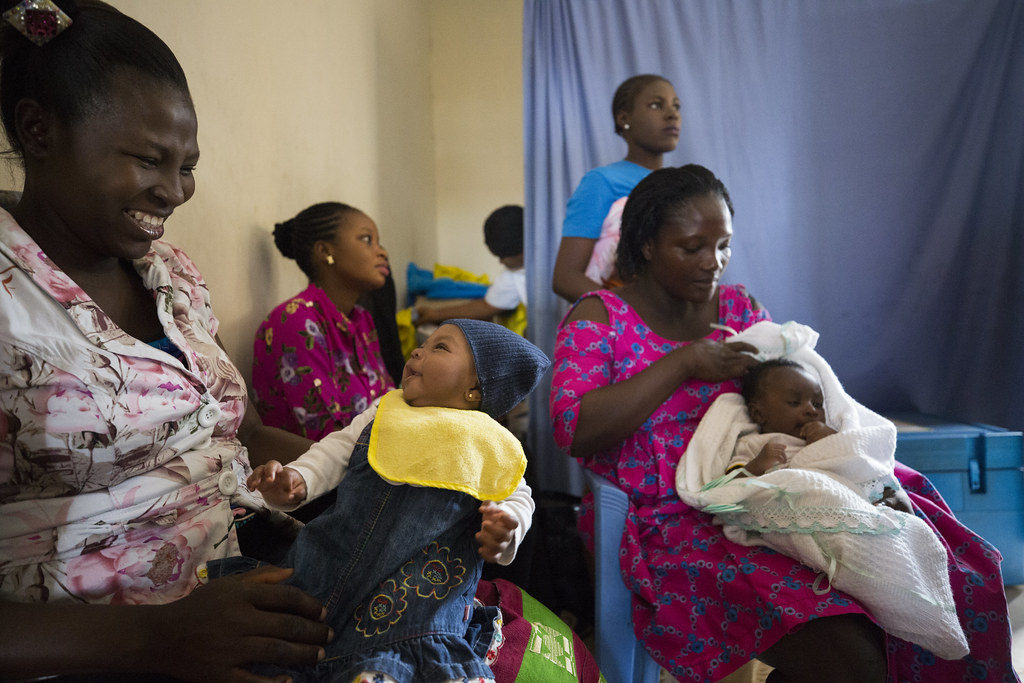根據,到了2050年,地球上將有大約97億人口,比今日人口多20億,印度人口數將超過中國,成為人口最多的國家,撒哈拉以南的非洲人口將增加一倍。到了本世紀末,地球人口將高達110億。
然而,總體人口成長率將持續下降。根據該報告,預計到了2100年世界人口將幾乎停止成長。

2019年5月1日上海市街頭人潮。圖片來源:Mussi Katz(CC0 1.0)
該報告由聯合國經濟和社會事務部人口司出版,全面性地概述了全球人口模式和前景。根據1950年至今235個國家或地區的人口估計值,歷史人口趨勢分析奠定了報告內容。
皮尤研究中心(Pew Research Center)上週根據此份聯合國報告公布的資料表明,全球生育率下降將使本世紀末人口停滯在約109億,年成長率不到0.1%。
從現在到2050年,印度預計將成為人口成長最快的國家,到2027年左右將超過中國成為世界上人口最多的國家。從現在到2050年,印度和其他八個國家將佔人口成長估計值的一半以上。
預計人口增幅最大的九個國家是印度、尼日、巴基斯坦、剛果民主共和國、衣索比亞、坦尚尼亞、印尼、埃及和美國。
整體來說,撒哈拉以南的非洲人口到2050年將成長一倍。
這些國家的人口在全球生育率趨緩的情況下逆勢成長。1990年,每名婦女平均生3.2個孩子。2019年,每名婦女生育2.5個孩子。到了2050年,出生率預計將再降至2.2個。
在沒有移民的情況下,為了避免全國人口長期下降,每名婦女必須生育2.1個孩子。
越來越多國家的人口規模正在下降。自2010年以來,由於生育率持續低下,27個國家或地區人口至少下降了一個百分點。
從現在到2050年,人口減少1%或以上的國家預計將擴大到55個。其中幾乎一半的國家將減少至少10%。
在某些情況下,人口下降伴隨著高移民率,移民已成為某些地區人口變化的主要原因。
由於對移民工人的需求,孟加拉國、尼泊爾和菲律賓出現了最大的移民外流潮。緬甸、敘利亞和委內瑞拉是因暴力、不安全或武裝衝突而外流人口最多的國家。
人口數下降能被移民填補的國家包括白俄羅斯、愛沙尼亞和德國。
聯合國經濟和社會事務副秘書長劉振民說:「許多人口快速成長的國家是貧窮的國家,人口成長帶來了額外的挑戰,包括貧困、飢餓和營養不良,平等以及醫療保健和教育。」

奈及利亞一家健康中心正在教授新手媽媽營養課程。圖片來源:Global Financing Facility(CC BY-NC-ND 2.0)
同時,人口成長為許多發展中經濟體帶來機會。生育率下降意味著工作年齡人口(一般認為是25至64歲)的成長速度超過其他年齡段,這可能會提高經濟成長速度。
該報告建議政府利用這種「人口紅利」來投資於教育和健康。
雖然較貧窮國家的預期壽命仍然較低,但人口結構中,老年人的比例正在增加。聯合國報告發現,未來將有更多國家必須適應人口老齡化的後果。
到2050年,將有1/6的人口超過65歲,高於目前的1:11。部分地區將在30年內經歷老年人的比例翻倍,包括北非、亞洲和拉丁美洲。
到2050年,歐洲和北美洲可能有1/4的人口達到65歲或以上。隨著公共衛生、養老金和社會保障體系的成本增加,未來幾十年老年人的比例和人數也將增加。
Global Population to Hit 11 Billion by 2100, Then Slow NEW YORK, New York, June 17, 2019 (ENS)There will be roughly 9.7 billion people living on Earth by the year 2050, an increase of two billion over today's population, finds a UN population report released today. India is predicted to overtake China, today's most populous country by 2050; and the population of sub-Saharan Africa is projected to double.
The World Population Prospects 2019: Highlights," estimates that the next 30 years will see today's global population of 7.7 billion add another two billion people, and, by the end of the century, the planet will have to sustain around 11 billion people, the report shows.
Yet, the overall population growth rate will continue to fall, and according to the report, the world's population is expected to virtually stop growing by 2100.
The report is published by the Population Division of the UN Department of Economic and Social Affairs and provides a comprehensive overview of global demographic patterns and prospects. Based on population estimates from 1950 to the present for 235 countries or areas, it's underpinned by analyses of historical demographic trends.

印度一家「Anganwadi」(印度農村的兒童保健中心)的保健志工。圖片來源:Public Services International(CC BY-NC 2.0)
Data released by Pew Research Center on Monday based on the same UN report indicates that falling global fertility rates will lead to a population of about 10.9 billion people at the end of the century, with what analysts say is annual growth of less than 0.1 percent.
India is expected to experience the greatest population increase between now and 2050, overtaking China as the world's most populous country by around 2027. India, along with eight other countries, will make up over half of the estimated population growth between now and 2050.
The nine countries expected to show the biggest population increases are India, Nigeria, and Pakistan, followed by the Democratic Republic of Congo, Ethiopia, Tanzania, Indonesia, Egypt, and the United States.
In total, the population of sub-Saharan Africa is expected to practically double by 2050.
Population growth in these countries will happen against the backdrop of a slowing global fertility rate. In 1990, the average number of births per woman was 3.2. By 2019 this had fallen to 2.5 births per woman and, by 2050, the birth rate is projected to decline further to 2.2 births.
In the absence of immigration, a fertility level of 2.1 births per woman is necessary to avoid national population decline over the long run.
The population size of more and more countries is falling. Since 2010, 27 countries or areas have seen a drop of at least one percent, because of persistently low fertility rates.
Between now and 2050, the group of countries that will see a population decrease of one percent or more is expected to expand to 55. And almost half of these will experience a decrease of at least 10 percent.
In some cases, the falling population size is accompanied by high rates of emigration, and migration flows have become a major reason for population change in certain regions.
Bangladesh, Nepal and the Philippines are seeing the largest migratory outflows resulting from the demand for migrant workers; Myanmar, Syria and Venezuela are the countries where the largest numbers are leaving because of violence, insecurity or armed conflict.
For those countries where the population is falling, immigration is expected to fill the gaps, particularly in Belarus, Estonia and Germany.
"Many of the fastest growing populations are in the poorest countries, where population growth brings additional challenges," said Liu Zhenmin, United Nations Under-Secretary-General for Economic and Social Affairs. These challenges include the fight to eradicate poverty, and combat hunger and malnutrition; greater equality; and improved healthcare and education.
At the same time, growth is providing opportunities in many developing economies. Recent reductions in fertility mean that the working-age population, considered to be 25 to 64, is growing faster than other age ranges, which could improve the possibilities for faster economic growth.
The report recommends that governments make use of this "demographic dividend" to invest in education and in health.
The proportion of older people in the population is increasing, although life expectancy is still lower in poorer countries. In the future, more countries will have to adapt to the consequences of an aging population, the UN report finds.
There will be one in six people older than 65 by 2050, up from the current figure of one in 11. Some regions will see the share of older people double in the next 30 years, including Northern Africa, Asia and Latin America.
By 2050, a quarter of the population in European and Northern America could be 65 years of age or over. The higher proportion and number of older people is expected to put increased financial pressure on countries in the coming decades, with the higher cost of public health, pensions and social protection systems.
※ 全文及圖片詳見:
作者
如果有一件事是重要的,如果能為孩子實現一個願望,那就是人類與大自然和諧共存。
於特有生物研究保育中心服務,小鳥和棲地是主要的研究對象。是龜毛的讀者,認為龜毛是探索世界的美德。
本站聲明:網站內容來源環境資訊中心https://e-info.org.tw/,如有侵權,請聯繫我們,我們將及時處理
【其他文章推薦】※彰化搬家費用,南投搬家費用,距離,噸數怎麼算?達人教你簡易估價知識!
※專業家事服務範圍有哪些?冷氣機清洗,床墊清洗?不止比你想像多更多
搬家前必知的8 件事情!價格、費用、便宜、優質桃園搬家公司哪裡找?
※床墊清潔難處理,專業達人教你強效清理
Orignal From: 聯合國:2100年全球人口將達100億,然後成長趨緩
留言
張貼留言